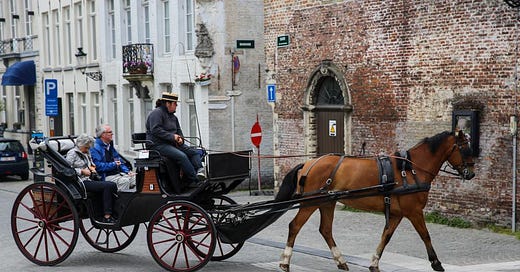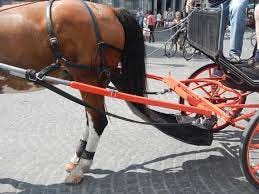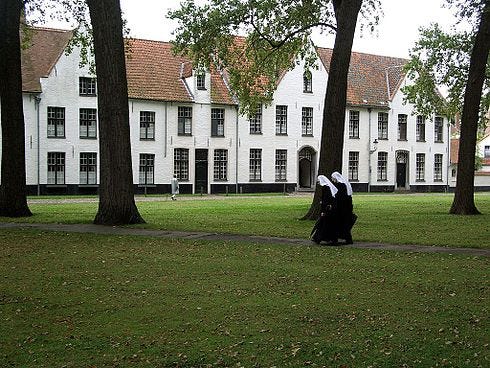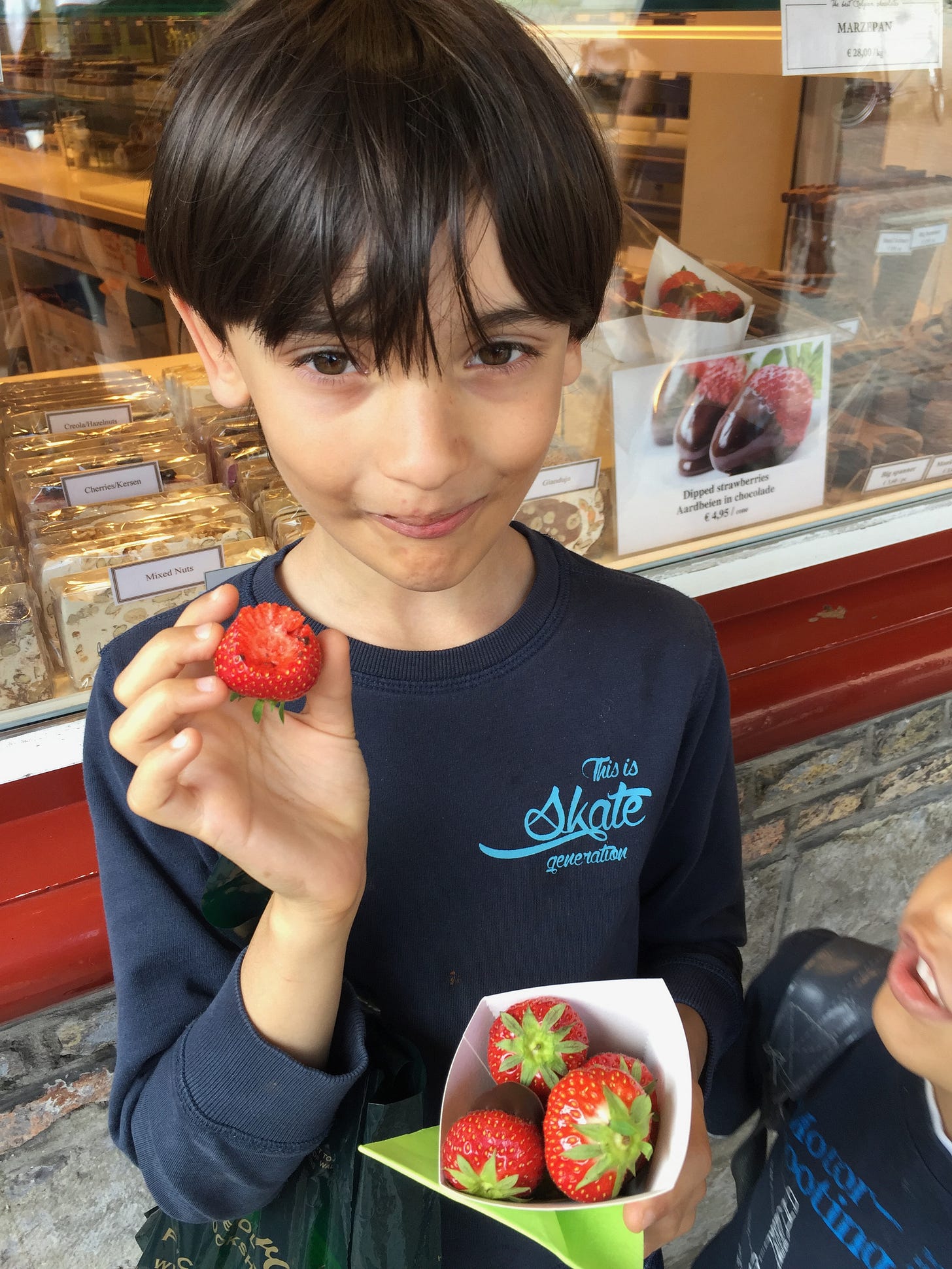Ni hao pengyoumen,
The moment you begin to dip a curious toe into global waters you can’t help but notice how what is commonplace in other countries, could greatly improve life in your own. For example, in Japan, artistic manhole covers elevate sanitation to art.
(Let me know other examples you can think of in the comments)
But the first time I had this epiphany was several years ago, during the years I lived in Brussels. I visited the picture post-card town of Bruges, as one does, and found my attention not so much focused on the medieval canals and cobble stoned streets, as on the horses that clippety-clopped about - and more specifically, on their poo.
Taking in Bruges from a horse-led carriage is a tourist staple. And we know that horses need to – erm, use the washroom often and copiously. The result could have been a malodorous disaster for the town, making its signature scent of chocolate a little more complex than just cocoa, butter, and sugar.
But the horses in Bruges, were outfitted with a contraption that was a cross between a diaper and a chute: a nifty little cloth bag attached just under the horse's privates, with the other end fastened to the front of the carriage. The result: the old-world charm of horse and carriages without unwelcome old-world olfactory accompaniments.
Horse “diaper/poo chute” Pic credit: Pallavi Aiyar
I ended up in a reverie imagining the revolutionary potential in India of cow diapers, camel diapers, buffalo diapers and the mother of all poo-holders- the elephant diaper.
And it was filled with such unholy thoughts that I found myself entering a white brick compound that was blanketed in a deep, almost sacred silence, save for the distant hooting of a wood pigeon. Horse poo thoughts dissipated as two nuns approached: one was as gnarled as the roots of the ancient trees clustered in the grove; the other butter-cheeked and youthful. I had wandered into the town’s beguinage.
I stepped aside to let the women pass, my eyes downcast in apology for having intruded. The younger one flashed me a distinctly un-nun-like grin. Dressed in long black robes topped with white habits, these Benedictine nuns offered a looking glass through which to peer through the centuries to the beginnings of what was arguably the first feminist movement in the world: that of the beguines.
These were women from the Low Countries who from the 12th century on began to live in communes called beguinages forming self-help groups that allowed them a life independent of either the care of a man, or the vows of the church. They were a motley crew of widows, wives whose husbands were fighting abroad in the crusades, and spinsters. What beguines had in common was a certain religious-mindedness and a desire to control their own lives.
They made lace, worked as hospital nurses and teachers, gave lessons to children, and carved out a space in society for themselves as pious, independent women. This was something almost unimaginable in the patriarchal world of the time. What’s more, a beguine was free to leave the beguinage and get married, unlike a nun who was bound by vows to the church for life.
Beguinage in Bruges. Pic credit: Wikipedia
The last beguine to live in the Bruges beguinage, now a Unesco world heritage site, died in the 1920s. Since then, two dozen or so Benedictine nuns have taken up residence here, a space they are compelled to share with throngs of tourists.
Bruges is the quintessential tourist paradise, visited by more than 3 million tourists annually (in pre Covid times). Virtually all of the 20,000-strong local population work in occupations that cater to these hoards. The town advertises itself as the world capital of chocolate, a well-deserved moniker, evidenced by the fact that it is home to a mouth-watering 54 chocolate shops. The result is a town that felt edible. The scent of vanilla and coco was so ubiquitous that I had to resist attempting to take bites out of the churches and bridges.
(It’s actually possible to on chocolate safaris in Bruges and learn all about fascinating facts like how the Mayans used to mix it is with blood as an offering to sweet-toothed Gods! )
My boys getting on intimate terms with some chocolate dipped strawberries in Bruges. Pic Credit: Pallavi Aiyar
At Sukerbuyc, Bruges’ oldest chocolate shop, the chocolate is mixed on site in a room at the back. Mr Sukerbuyc, who runs the outfit along with his wife, recalled how when he started up the business back in 1976, people scoffed at him. “A chocolate shop?” they would say. “Pfff! You’ll never survive.”
Today the much-vindicated chocolatier has expanded his business to include a tea shop right across from his chocolaterie. I sipped a cuppa accompanied by a whirl of confectionery. It was just the pick-me-up I needed before my next appointment at the city archives.
I met with Noel Geirnaert, the town’s head archivist, in his office. He had the pale skin of one who spent a lot of time indoors reading heavy books. Unsurprisingly, he had several such books to show me: gorgeous leather-bound tomes of parchment and paper dating from the 13th and 14th centuries.
“Look,” he said with the excitement of a child at an ice-cream van. “This one belonged to one Guillaume Ruyelle, an Italian merchant. It shows how sophisticated bookkeeping was even back then.” I stared at the carefully recorded numbers and spiky writing across the page; a whisper from the distant past when Bruges was not merely a tourist attraction but the financial center of Europe, a city where great fortunes were made and lost and merchants from the far ends of the continent congregated to conduct their business.
Medieval Bruges’ success lay in the access that the river Zwyn gave it to the sea. As goods began to be transported by ship rather than overland, the town’s port expanded and was soon the gateway to all the major industrial and agricultural products of Europe. It attracted merchants and bankers from the great Italian trading cities of Venice, Genoa, and Florence.
It then became the overseas headquarters of a vitally important group of trading towns of northern Germany called the Hanseatic League which controlled all the commercial activity of the Baltic and the North Seas. It was in Bruges that the old barter system of trade was replaced by a modern system of cash and credit. And it was also the home of the first stock exchange in the world.
I walked across to the house that used to function as the Van der Buerse family inn. This is the building where the first stock exchange is believed to have evolved, as commodity traders who gathered in and around the inn gradually institutionalized their once-informal meetings. Hence the words for “stock exchange” in French, bourse, and in Dutch, beurs, derive from the innkeepers’ family name, Buerse.
****
As the summer holidays approach, I think many of us are looking forward to some long-delayed and well-deserved travel. Hope this piece has whetted your appetite, in more ways than one, for the globe-trotting I hope lies ahead of you.
Could I also ask you to please subscribe to this newsletter? It takes effort, travel, and time to bring it to you, and a small contribution would go a long way in helping me keep at it.
Do share the Global Jigsaw with your contacts.
And bon voyage if you are heading off somewhere soon. Drop me a note re your favourite destinations, and as I mentioned at the outset, keep your eyes peeled for those nifty things elsewhere does better. Viva horse diapers!
Hasta la proxima semana,
Un abrazo fuerte,
Pallavi








Ha,ha!! We could export those horse nappies to Sevilla, over 50..000 in the Feria; and think of all the chocolate we could buy with the profits :-)!
This was delightful. I loved your reverie, I could visualise the un-nun-like smile, smell the scent of chocolate, imagine the bites of churches and bridges.. Looking forward to digging into the archive and reading more of your words.. :)